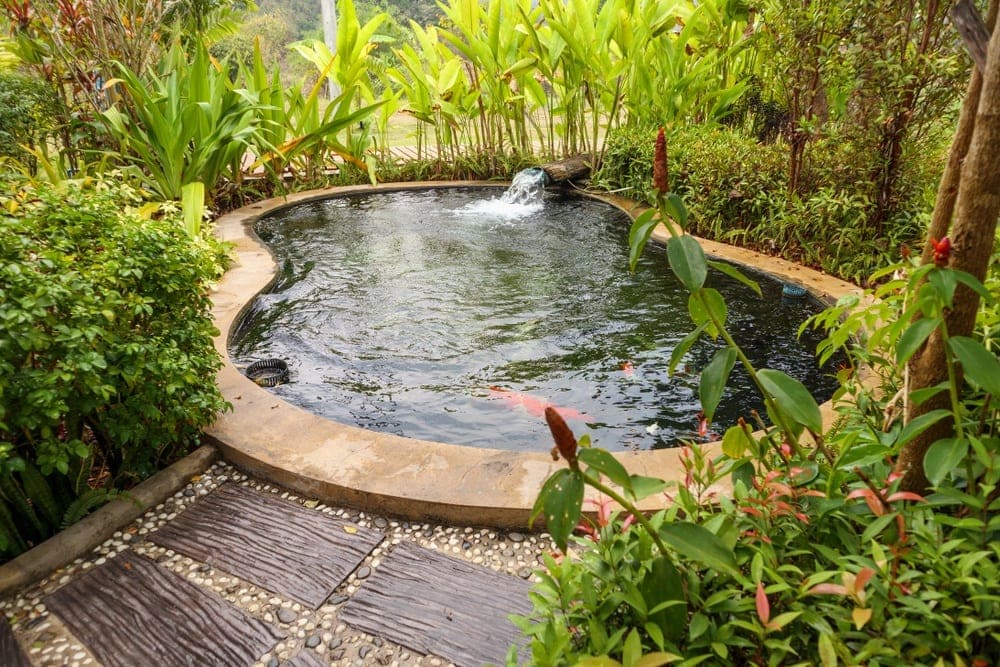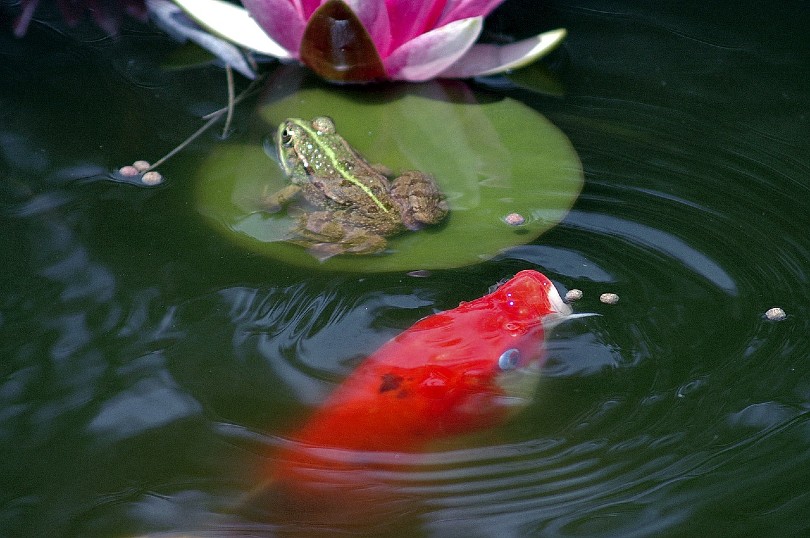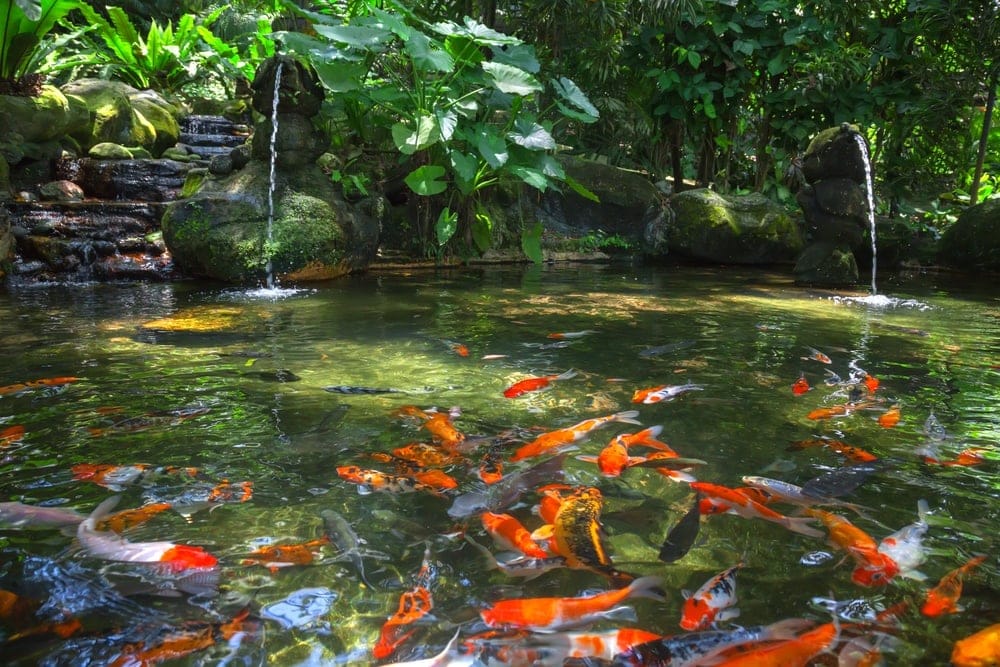If you have any kind of indoor or outdoor pond for your fish, you obviously want to provide them with the best home possible. One of the most important things to consider with ponds is the water. After all, fish cannot live outside of water, so this is crucial no doubt. However, simply having water in the pond is not good enough.
The water needs to be the right water, treated the right way, with the right parameters. You can’t just go and pour a bunch of water from your tap or hose into a pond for fish. That will not end well by any means.
Tap water is not safe for ponds, unless it’s been treated. The problem here is the chlorine. How to make tap water safe for ponds is what we are here to talk about right now. There are ways to remove chlorine and its derivatives or manmade compounds from the water, so fear not.

The Problem With Tap Water – Chlorine
The main problem that tap water brings to the pond is chlorine. All tap water in our world, in developed countries anyway, is treated with various chemicals including chlorine. Chlorine is used to disinfect water, kill bacteria and parasites, to remove bad odors, and to make it consumable for humans.
Yes, chlorine might be fine to consume in small amounts (or so city officials claim), but it is definitely not safe for fish or for plants in a pond. Moreover, chloramine is often being used to treat tap water as well. While both chlorine and chloramine are not great for humans, they are deadly for fish.
Chlorine can actually evaporate into the air, which means that it is not all that hard to deal with on its own. However, many places are now using chloramine, which is a mix between ammonia and chlorine. This stuff does not evaporate into the air, making the problem just that much worse.

Why Is Chlorine Dangerous To Ponds & Fish
As you have probably gathered by now, chlorine is extremely dangerous to fish and pond plants alike. First and foremost, chlorine kills fish outright. There is no question about that. Chlorine damages a fish’s gills, scales, and breathing tissue. It literally burns them from the outside. Also, as it passed through their gills and digestive system, it also burns them from the inside out.
Chlorine can kill fish really fast. Moreover, chlorine also kills off all of the good bacteria in the pond. Ponds need to have beneficial bacteria that kill ammonia and nitrites. Without these bacteria, which are now dead because of chlorine, ammonia and nitrite buildups will kill the fish.
Now, add to the fact that most water uses chloramine for disinfecting, which is the mix of ammonia and chlorine, and you have a deadly cocktail that will kill your fish without question.

Chlorine vs Chloramine
Just to clarify, chlorine is terrible for fish, but chloramine is even worse. We know that chlorine kills fish in more ways than one. Well, the addition of ammonia to chlorine, which creates chloramine, causes even more problems. Water providers use chloramine to save money because it doesn’t evaporate out of water like chlorine does.
For people who have aquariums and ponds, this is a really big problem. This means that many solutions which would normally work to dechlorinate water don’t work for chloramine.
One of the first things that you want to do is to contact your local water company to see if they use chlorine or chloramine. You definitely don’t want to treat the tap water for chlorine, only to find out that chloramine is what has been used.

Measuring Chlorine In Water & Ponds
In all reality, the water you put in the pond should have absolutely no chlorine in it. When it comes to both chlorine and chloramine, the ideal level is 0.00 parts per million, or in other words, none at all. Both of these substances or compounds have no place in an aquarium or pond, they have no benefits whatsoever, and the only thing they will do is kill your fish.
It might be impossible to remove all chlorine and chloramine from tap water, but you should aim for levels as low as possible. 0.01 parts per million is an acceptable level, but even that is already pushing it.
Any more than that and you are asking for trouble. You can use an ammonia detection kit to measure your water for ammonia. If there is ammonia present, there is most likely chloramine in the water. There are special chlorine testing kits and electronic testing tools which are well worth getting (we have reviewed some good options over here).


How To Remove Chlorine From Water To Make It Safe For Fish
There are several ways that you can remove chlorine from the water to make it safe for pond fish. Keep in mind that not all of these methods work for chloramine, for the reasons we have discussed above. Some of the below methods will work for chloramine, but not all, so we will be sure to clarify but here is how to dechlorinate tap water for ponds.
Letting Water Stand
Ok, so this first method, to be crystal clear, only works for chlorine. You can let tap water stand for about 48 hours and the chlorine will simply evaporate out of it and into the atmosphere. Once again, chloramine does not dissipate into the atmosphere, so this method will not work for water that contains chloramine.
Water Conditioners
Probably the best and the most common option to go with is a water conditioner. You can find these at any fish keeping store. These conditioners work to remove chlorine, chloramine, and other poisonous and unwanted substances from the water.
Always be sure to read the directions though, because not quite all water conditioners out there can handle chloramine. Also read the directions in terms of dosing. Too much of this stuff is not good either. On that same note, some water conditioners need to be used before the water is added to the pond, while some can be added directly into the pond.
Activated Carbon Charcoal Filters
We are not going to get into the science of things here, but the fact is that activated carbon charcoal filters are great for removing chlorine, chloramine, and a ton of other substances from the water. This stuff can remove pollutants, pesticides, medicines, perfumes, chlorine, chloramine, and tannins from water.
These are all things which should not be in pond water for fish. It does work really well on its own, but is best used with a water conditioner or water that has already been treated. While it is a great measure to get rid of chlorine and chloramine, it should be used in conjunction with other methods for optimal results.
A Dechlorinator
Once again, we don’t want to get too technical here, but dechlorinators are like specialized aquarium filters dedicated to removing chlorine and chloramine from the water (we have reviewed some good ones here).
It’s pretty much a special aquarium filter with media designed to fight this problem. It is a good option to go with if you have a big pond with lots of fish and perform water changes fairly often.


Frequently Asked Questions
How To Add Water To Fish Pond Once The Water Is Safe?
Ok, so once you have made the tap water safe to add to a pond, which means treating it for pH, and getting rid of chlorine too, you need to add it into the pond.
Now, you cannot just dump a massive amount of water into the pond at once, especially not if you are replacing older water.
- Make sure to leave the water out for long enough so that it reaches the same temperature as the rest of the pond. You don’t want to add water that is much cooler or warmer than the current pond water, or else you will run into issue in terms of temperature shock.
- You also want to add the water in a slow and consistent manner. Don’t just dump it all in at once with a big splash. You want to disturb as little of the substrate and as few of the plants as possible. Do it slow and steady.
- Try to avoid pouring the water into the pond right above fish or plants. Nobody likes getting water dumped on their heads, whether people, fish, or plants. The bottom line here is to just be a bit careful and don’t rush things along too fast.
- Although this tips list should be for water that is already safe, always be sure to treat the water first!
How Often Do You Change Water In A Fish Pond?
First off, just like with normal aquariums, it is recommended that you change a specific portion of the water once per week. This means once per week, not once every 5 days and not once every 9 days, once per week.
Now, how much of the water you change will depend on the size of the pond. Any pond under 5,000 gallons will do just fine with a 10 to 15% water change per week, whereas anything over 5,000 gallons should do fine with 5 to 10% new water per week.
Remember that debris and waste builds up faster in smaller ponds than in larger ones, which is why smaller ponds require a larger amount of water to be changed on a weekly basis.
Can I Top Up My Fish Pond With Tap Water?
Techincally speaking, yes you can top up your pond with some tap water if it is running low, but it is important to remember to perform a pond chlorine treatment.
In other words, if you plan on adding tap water to koi ponds, make sure to let it rest for at least a full day to allow the chlorine to dissipate. If you add chlorinated water into your fish pond, you will kill every living thing in there.
Moreover, there are also other substances that may be contained in tap water, depending on where you live, so you may need to perform additional treatment steps as well.
Can Pond Fish Survive In Tap Water?
Once again, yes, but it needs to be treated first. You need to ensure that the tap water no longer contains chlorine or other harsh chemicals used to treat tap water, you need to get the temperature right, and you need to even out the pH level too.
Once you have done all of this, then yes, fish can survive in tap water. However, it’s important to note that tap water straight out of the faucet, if not treated by you, will most definitely kill your fish a very short amount of time.
How Long Do You Leave Tap Water Before Adding Fish In A Pond?
We recommend 48 hours (2 days) to allow enough time for the Chlorine to evaporate, as we mentioned earlier letting the water stand will only work for chlorine only.


Conclusion
No matter what the case, always remember that you need to treat tap water for chlorine or chloramine before adding it into a fish pond. The above methods on their own work well, but in conjunction with one another they work the best.
See also:
Feature Image Credit: romarti, Shutterstock
